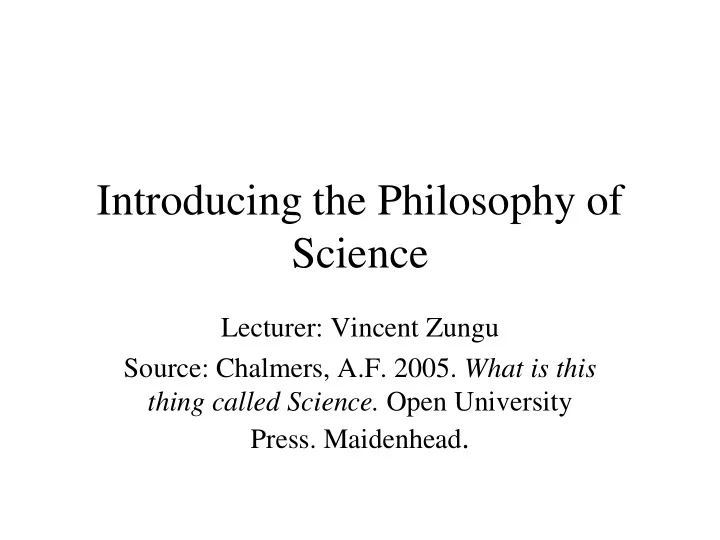

Introducing the Philosophy of Science Lecturer: Vincent Zungu Source: Chalmers, A.F. 2005. What is this thing called Science. Open University Press. Maidenhead .
“Unprejudiced seeing?” • Two people viewing the same object do not always see the same thing. Figure 1 on page 6. • What do you see? Is it a staircase or just a collection of lines. If it is a staircase, is it one from above or below?
Observation: passive and private or public and active • How observation is commonly understood by philosophers? • What is observation as passive and private or public and active affair? • What is the role of observation in Science?
Observation: passive and private or public and active • Common understanding of observation by range of philosophers: seen as passive, private affair. • Passive – when seeing we simple open and direct our eyes, let the information flow in, and then record what is there to be seen. • Private – it is the perception itself in the mind that is taken to directly validate the observable facts.
Observation: passive and private or public and active • Example – One can see that an object in front of his is a Tomato! • Note- the above act is accomplished by individual closely attending to what is presented to him/her in the act of percetion • However- it does not provide an accurate account of perception in everyday life or even in science. • There are range of things that are done to establish the validity of perception.
Observation in Science Public and Active • Our task is to consider the role of observation in science. • E.g. the early use of microscope in science. • Robert Hooke and Henry Powers used the microscope to look at the small insects and ants. • These scientists often disagree about observable facts initially. Hooke traced the nature of the disagreements.
Observation in Science Public and Active • He pointed out that the eye of a fly appears like a lattice covered with holes in one kind of a light. • Powers agreed but also mentioned that it appears like a surface covered with cones in another and in yet another light like a surface covered with pyramids. – Important to note that above scholars sees the same objects but with different descriptions. – The question: is which one of these provides accurate description?
Observation in Science Public and Active • Hooke then proceeded to make practical intervention designed to clear up the problem. How? • Eliminate spurious information arising from dazzle and complicated reflections by illuminating specimens uniformly. • Micrographia (1665) book came out with many detailed descriptions and drawings that resulted from Hooke’s actions and observations.
Observation in Science Public and Active • These productions were and are public, not private. • They can be checked, criticised and added to by others. • Therefore the observable facts about the structure of a fly’s eye that eventuate result from a process that is both active and public. • If actions are taken to explore the validity of claims – thus subjective aspects of perception need not to be a problem for science
Observation in Science • Perceptions of the same scene can vary from observer to observer – their background, culture and expectations. • This problem can be eliminated by taking appropriate action. • The perceptual judgements of individuals can be unreliable for a range of reasons. • Challenge: in science is to arrange the observable situation in way that the reliance on such judgments is minimised.
Observation in Science Vertical View Horizontal View
Observation in Science • Moon illusion is a common phenomenon. • High in the sky – appears much smaller than when it is low on the horizon. • However – do not have to put trust on the subjective judgement about the moon size • But what do we do to reduce subjective view of the moon size. • Can mount a sighting tube fitted with cross wires – so that its orientation can be read on a scale.
Observation in Science • This can be done when the Moon is high on the sky and repeatedly done when it is horizontal. • Findings- the moon remain unchanged – indicating that there is no significant variations and differences between the scale readings in two cases.
Observation in Science • Key points to learn: • Observation statement constitute worthy of forming basis for science – straightforwardly tested by senses and withstands those tests. • OS – their validity can be tested in ways that involve routine, objective procedures that do not necessitate fine, subjective judgements on the part of observer. • This brings out the Active, public character of the vindication of OS.
Observation in Science • Small price has to be paid for the notion of an observable fact (OF). • That price is that (OF) are to some degree fallible and subject to revision. • If OF passed the testes – does not mean that it will survive new kinds of tests that become possible in the light of advances in knowledge and technology. • E.G. The earth is Stationary and second – the apparent size of Mars and Venus do not change appreciably during the course of the year.
Observation in Science • Therefore we can conclude that observation worthy of forming basis for scientific knowledge are both objective and fallible. • Objective – because they can be publicly tested by straightforward procedures And • Fallible – they may be undermined by new kinds of tests made possible by advances in science and technology
Essay Question ? • Discuss how observation statement can form the basis for scientific knowledge. Answer your question by providing relevant examples to show understanding of the topic. (Essay must be 5 pages!!!). Due date: 15 August 2011)
Recommend
More recommend